MaryAnn Bernal's Blog, page 270
June 12, 2014
5-Million-Year-Old Arctic Fox Ancestor Found in Tibet
By Tia Ghose
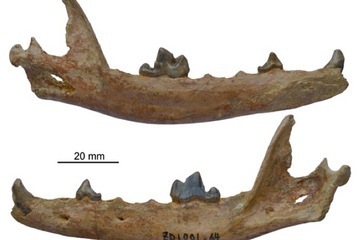
 The jaw and teeth of an ancestor to the Arctic Fox were found in Tibet
The jaw and teeth of an ancestor to the Arctic Fox were found in Tibet
Credit: Xiaoming Wang
The fossilized jawbone and teeth of a 5-million-year-old fox have been unearthed in Tibet.
The fox, Vulpes qiuzhudingi, is probably the ancestor of modern Arctic foxes. The discovery, along with several other fossils from cold-loving mammals, buttress the Out of Tibet hypothesis: That iconic ice-age mammals such as woolly mammoths, saber-toothed tigers and giant sloths first evolved for the cold weather in Tibet before fanning out over the steppes of Central Asia and into North America.
Several years ago, paleontologists excavating the Zanda Basin in Tibet unearthed a 3.7-million-year-old woolly rhino fossil that not only was older than all other fossils of the species, but also was found much farther south than those prior specimens. At that time, the Arctic was much warmer than it is today, whereas the snowy, high Tibetan plateau was just a touch warmer, said study co-author Zhijie Jack Tseng, a paleontologist at the American Museum of Natural History in New York. [High & Dry: Images of the Himalayas and the Tibetan Plateau]
That led the researchers to propose that the frigid, high-altitude climate of Tibet was a staging ground where many of the shaggy-coated, cold-loving megafauna first adapted to the cold. When Earth's temperatures plunged at the onset of the last ice age about 2.6 million years ago, these cold-loving creatures emerged from the Tibetan plateau to colonize most of the Arctic and colder portions of North America.
Living relative
In 2006, the researchers also found a single tooth in the Zanda Basin, but couldn’t match it to a specific animal species. Over the next several years, they went on to find two other fossils that revealed the lower jaw and some of the teeth from ancient predatory foxes, allowing them to identify the original tooth as well.
 [image error]
[image error]
 The Zanda Basin in Tibet.
The Zanda Basin in Tibet.
Credit: Xiaoming WangView full size image
The fox fossils ranged from 3.6 million to 5 million years old, and the teeth looked a lot like those of the modern Arctic fox, which now lives across the Arctic, from Scandinavia and Russia in the west all the way to Greenland and Iceland.
"The arrangement of the cusps on the tooth are more or less in a straight line and pretty sharp," Tseng told Live Science. "That meant that the fox was using that tooth for cutting and shearing meat," just as the Arctic fox does today.
The discovery marks the first time that an older predecessor to a modern Arctic creature has been found in Tibet, buttressing the Out of Tibet hypothesis, Tseng said.
The team has also found other fossils from archaic, cold-adapted mammals throughout Tibet, such as ancient snow leopards, wolf-sized dogs and hyenas. And, just like modern Arctic species that must subsist mainly on meat during the long, frosty winter months when plant-based food is almost nonexistent, these ancient animals were more carnivorous than similar animals that live in more temperate climates, Tseng said.
The findings were published Tuesday (June 10) in the journal Proceedings of the Royal Society B.
http://www.livescience.com/46268-arctic-fox-ancestor-tibet.html


 The jaw and teeth of an ancestor to the Arctic Fox were found in Tibet
The jaw and teeth of an ancestor to the Arctic Fox were found in TibetCredit: Xiaoming Wang
The fossilized jawbone and teeth of a 5-million-year-old fox have been unearthed in Tibet.
The fox, Vulpes qiuzhudingi, is probably the ancestor of modern Arctic foxes. The discovery, along with several other fossils from cold-loving mammals, buttress the Out of Tibet hypothesis: That iconic ice-age mammals such as woolly mammoths, saber-toothed tigers and giant sloths first evolved for the cold weather in Tibet before fanning out over the steppes of Central Asia and into North America.
Several years ago, paleontologists excavating the Zanda Basin in Tibet unearthed a 3.7-million-year-old woolly rhino fossil that not only was older than all other fossils of the species, but also was found much farther south than those prior specimens. At that time, the Arctic was much warmer than it is today, whereas the snowy, high Tibetan plateau was just a touch warmer, said study co-author Zhijie Jack Tseng, a paleontologist at the American Museum of Natural History in New York. [High & Dry: Images of the Himalayas and the Tibetan Plateau]
That led the researchers to propose that the frigid, high-altitude climate of Tibet was a staging ground where many of the shaggy-coated, cold-loving megafauna first adapted to the cold. When Earth's temperatures plunged at the onset of the last ice age about 2.6 million years ago, these cold-loving creatures emerged from the Tibetan plateau to colonize most of the Arctic and colder portions of North America.
Living relative
In 2006, the researchers also found a single tooth in the Zanda Basin, but couldn’t match it to a specific animal species. Over the next several years, they went on to find two other fossils that revealed the lower jaw and some of the teeth from ancient predatory foxes, allowing them to identify the original tooth as well.
 [image error]
[image error]
 The Zanda Basin in Tibet.
The Zanda Basin in Tibet.Credit: Xiaoming WangView full size image
The fox fossils ranged from 3.6 million to 5 million years old, and the teeth looked a lot like those of the modern Arctic fox, which now lives across the Arctic, from Scandinavia and Russia in the west all the way to Greenland and Iceland.
"The arrangement of the cusps on the tooth are more or less in a straight line and pretty sharp," Tseng told Live Science. "That meant that the fox was using that tooth for cutting and shearing meat," just as the Arctic fox does today.
The discovery marks the first time that an older predecessor to a modern Arctic creature has been found in Tibet, buttressing the Out of Tibet hypothesis, Tseng said.
The team has also found other fossils from archaic, cold-adapted mammals throughout Tibet, such as ancient snow leopards, wolf-sized dogs and hyenas. And, just like modern Arctic species that must subsist mainly on meat during the long, frosty winter months when plant-based food is almost nonexistent, these ancient animals were more carnivorous than similar animals that live in more temperate climates, Tseng said.
The findings were published Tuesday (June 10) in the journal Proceedings of the Royal Society B.
http://www.livescience.com/46268-arctic-fox-ancestor-tibet.html

Published on June 12, 2014 11:21
In the Midst: 12 ways to keep your nonfiction book in the news
In the Midst: 12 ways to keep your nonfiction book in the news: Publishers are willing to publicize nonfiction books when they're released, but they rarely do much after the launch to keep books in t...

12 ways to keep your nonfiction book in the news
Publishers are willing to publicize nonfiction books when they're released, but they rarely do much after the launch to keep books in the news, even though most deserve ongoing media exposure. Here are some easy things you can do to generate continuing publicity for your title. Use a mix of these ideas to develop a 12-month publicity plan that will provide the support your book needs.
1. Turn the advice in your chapters into a series of monthly tip sheets. A tip sheet is a press release that offers tips or advice in a bulleted or numbered format. Start your tip sheet with an introductory paragraph that explains why the tips you're offering are important, list your bulleted advice, then tie it all together at the end with a concluding paragraph. Send it to appropriate media outlets; the distribution list will depend on your topic.
2. Contact the press immediately when your topic is making headlines to offer your expert perspective. This is a sure thing with most local media outlets when it's a national news story because you're giving them a local angle. Fax or e-mail (no attachments) your bio and a cover letter explaining your position on the breaking news to the appropriate media contact. If you've done enough interviews to prepare for the big time, pitch the national news outlets, too.
3. Add the media to your newsletter distribution list. The same useful advice or information you offer subscribers in your print or electronic newsletter could be of interest to reporters covering that topic, too. I got a book contract several years ago from the publicity that resulted from adding the media to the distribution list of a newsletter I publish.
4. Repackage your book content into by-lined trade magazine articles. Depending on the terms of your publishing contract, you might need to do some rewriting so it's “new” material. Make sure the author credit at the end of the article includes your book title.
5. Capitalize on holidays and special months, weeks and days by distributing a press release with useful, newsworthy information related to the topic, or by contacting the press to offer yourself as an expert information source. For example, many daily newspapers run articles in December about how the holidays are especially difficult for people who are grieving the recent loss of a loved one or facing the anniversary of a loss. This presents many coast-to-coast interview opportunities for the author of a book on grief and loss - but only if the author reaches out to the press.
6. Contact the public relations department of your industry's trade association to offer yourself for media interviews. Association public relations people are often contacted by writers like us looking for members with a particular expertise to interview. Make sure your association knows about your qualifications and the topics you can comment on, and you'll get referral calls.
7. Conduct a newsworthy and relevant survey on your topic and announce the interesting results in a press release. The author of a cookbook designed to make cooking simple and easy can survey people about why they don't cook more, and release the findings in a press release sent to newspaper food editors and cooking magazines. The release should include information about your book's connection to the survey topic.
8. Sponsor an attention-getting contest and announce the results in a press release. To promote my humor book about men, I conducted a “Worst Gift from a Man Contest.” The resulting press release led to nationwide media attention, including a holiday appearance on a national cable TV talk show.
9. Subscribe to Reporter Connection and HARO and monitor them for publicity opportunities. These free services connect journalists with experts and anecdote sources. Respond only to queries where you can make a definite contribution, and respond thoughtfully with information that helps the journalist understand why you're an excellent resource for the article or segment.
10. Monitor writer forums for source requests. Members frequently post requests on the magazines and newspapers forum for interview sources.
11. Tell the media when you're visiting their market. Reporters love to interview experts who aren't local, so if you're in another city for any reason, contact the appropriate media people two weeks before your trip to offer ideas for articles they can write based on an inperson interview with you. If you're in town to speak, send an announcement press release several weeks in advance and offer to do a pre-event telephone interview.
12. Repurpose your best tips into a free booklet. Write and distribute a press release that describes the booklet and how people can get a free copy; make sure both the booklet and the release include information about your book, too.
Generating ongoing publicity is work, but it's not rocket science. Invest the time so you boost sales while contributing to your author platform. You'll see the rewards at the end of the year.
You have permission to reprint the article with this required author credit:Sandra Beckwith offers a free book publicity and promotion e-zine at www.buildbookbuzz.com and teaches the “Book Publicity 101: How to Build Book Buzz” e-course.

12 ways to keep your nonfiction book in the news
Publishers are willing to publicize nonfiction books when they're released, but they rarely do much after the launch to keep books in the news, even though most deserve ongoing media exposure. Here are some easy things you can do to generate continuing publicity for your title. Use a mix of these ideas to develop a 12-month publicity plan that will provide the support your book needs.
1. Turn the advice in your chapters into a series of monthly tip sheets. A tip sheet is a press release that offers tips or advice in a bulleted or numbered format. Start your tip sheet with an introductory paragraph that explains why the tips you're offering are important, list your bulleted advice, then tie it all together at the end with a concluding paragraph. Send it to appropriate media outlets; the distribution list will depend on your topic.
2. Contact the press immediately when your topic is making headlines to offer your expert perspective. This is a sure thing with most local media outlets when it's a national news story because you're giving them a local angle. Fax or e-mail (no attachments) your bio and a cover letter explaining your position on the breaking news to the appropriate media contact. If you've done enough interviews to prepare for the big time, pitch the national news outlets, too.
3. Add the media to your newsletter distribution list. The same useful advice or information you offer subscribers in your print or electronic newsletter could be of interest to reporters covering that topic, too. I got a book contract several years ago from the publicity that resulted from adding the media to the distribution list of a newsletter I publish.
4. Repackage your book content into by-lined trade magazine articles. Depending on the terms of your publishing contract, you might need to do some rewriting so it's “new” material. Make sure the author credit at the end of the article includes your book title.
5. Capitalize on holidays and special months, weeks and days by distributing a press release with useful, newsworthy information related to the topic, or by contacting the press to offer yourself as an expert information source. For example, many daily newspapers run articles in December about how the holidays are especially difficult for people who are grieving the recent loss of a loved one or facing the anniversary of a loss. This presents many coast-to-coast interview opportunities for the author of a book on grief and loss - but only if the author reaches out to the press.
6. Contact the public relations department of your industry's trade association to offer yourself for media interviews. Association public relations people are often contacted by writers like us looking for members with a particular expertise to interview. Make sure your association knows about your qualifications and the topics you can comment on, and you'll get referral calls.
7. Conduct a newsworthy and relevant survey on your topic and announce the interesting results in a press release. The author of a cookbook designed to make cooking simple and easy can survey people about why they don't cook more, and release the findings in a press release sent to newspaper food editors and cooking magazines. The release should include information about your book's connection to the survey topic.
8. Sponsor an attention-getting contest and announce the results in a press release. To promote my humor book about men, I conducted a “Worst Gift from a Man Contest.” The resulting press release led to nationwide media attention, including a holiday appearance on a national cable TV talk show.
9. Subscribe to Reporter Connection and HARO and monitor them for publicity opportunities. These free services connect journalists with experts and anecdote sources. Respond only to queries where you can make a definite contribution, and respond thoughtfully with information that helps the journalist understand why you're an excellent resource for the article or segment.
10. Monitor writer forums for source requests. Members frequently post requests on the magazines and newspapers forum for interview sources.
11. Tell the media when you're visiting their market. Reporters love to interview experts who aren't local, so if you're in another city for any reason, contact the appropriate media people two weeks before your trip to offer ideas for articles they can write based on an inperson interview with you. If you're in town to speak, send an announcement press release several weeks in advance and offer to do a pre-event telephone interview.
12. Repurpose your best tips into a free booklet. Write and distribute a press release that describes the booklet and how people can get a free copy; make sure both the booklet and the release include information about your book, too.
Generating ongoing publicity is work, but it's not rocket science. Invest the time so you boost sales while contributing to your author platform. You'll see the rewards at the end of the year.
You have permission to reprint the article with this required author credit:Sandra Beckwith offers a free book publicity and promotion e-zine at www.buildbookbuzz.com and teaches the “Book Publicity 101: How to Build Book Buzz” e-course.

Published on June 12, 2014 04:39
History Trivia - Peasants' Revolt in England, rebels arrive at Blackheath.
June 12

28 Gaius Carrinas' triumphant procession through Rome.

1381 Peasants' Revolt in England, rebels arrived at Blackheath. Although the revolt did not succeed in its stated aims, it did succeed in showing the nobility what the peasants were capable of, which helped to form a radical tradition in British politics. 1

429 Hundred Years' War: Joan of Arc led the French army in their capture of the city and the English commander, William de la Pole, First Duke of Suffolk in the second day of the Battle of Jargeau.

1519 Cosimo de Medici was born.


28 Gaius Carrinas' triumphant procession through Rome.

1381 Peasants' Revolt in England, rebels arrived at Blackheath. Although the revolt did not succeed in its stated aims, it did succeed in showing the nobility what the peasants were capable of, which helped to form a radical tradition in British politics. 1

429 Hundred Years' War: Joan of Arc led the French army in their capture of the city and the English commander, William de la Pole, First Duke of Suffolk in the second day of the Battle of Jargeau.

1519 Cosimo de Medici was born.

Published on June 12, 2014 04:38
June 11, 2014
Writing and Rambling: Author Interview - Mary Ann Bernal
Writing and Rambling: Author Interview - Mary Ann Bernal: Joining me in the studio today, is Ms. Mary Ann Bernal. She is an author, a TV celebrity, and supporter of all things military. Mary Ann, ..
.
Writing and RamblingThe official (like there would be an unofficial?!) blog for the author R. Kyle Hannah. Check out my novels: ASSASSIN'S GAMBIT, TIME ASSASSINS and TO AID AND PROTECT!
Wednesday, June 11, 2014Author Interview - Mary Ann BernalJoining me in the studio today, is Ms. Mary Ann Bernal. She is an author, a TV celebrity, and supporter of all things military.
Mary Ann, tell me a little about yourself:

I am the author of The Briton and the Dane novels and an avid history buff whose area of interest focuses on Ninth Century Anglo-Saxon Britain during the Viking Age. While pursuing a degree in business administration, I managed to fit a few creative writing classes and workshops into my busy schedule. Unfortunately, it took decades before my “Erik the Viking” novel was ultimately published.

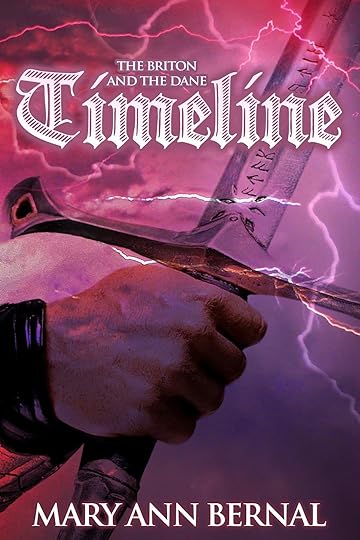
You said you were an avid supporter of the military?
Yes, I am a very passionate supporter of the United States military. I have been involved with letter writing campaigns and other support programs since Operation Desert Storm.
Thank you for that. As a veteran, its nice to feel appreciated. What is this I hear about a "celebrity" status?
Celebrity? Hardly. I have appeared on The Morning Blend television show hosted by KMTV, the CBS television affiliate in Omaha, and I was interviewed by the Omaha World-Herald for my volunteer work. I have also been a featured author on Triangle Variety Radio, The Phil Naessens Show, and The Writers Showcase, and have been interviewed extensively by American and European bloggers.
I would definitely call that "celebrity!" So, you live in Omaha?
I do currently reside in Omaha, Nebraska, but I am a New York “expat.”
So, leaving New York was on your bucket list? What other things would you like to cross off that list?
1. Getting my pilot’s license
2. Riding in a hot air balloon
3. Parachuting with my nephew, retired US Ranger
4. Attending the Indie 500
5. Spending a week walking the ruins of Pompeii
6. Visiting Stonehenge during the summer solstice
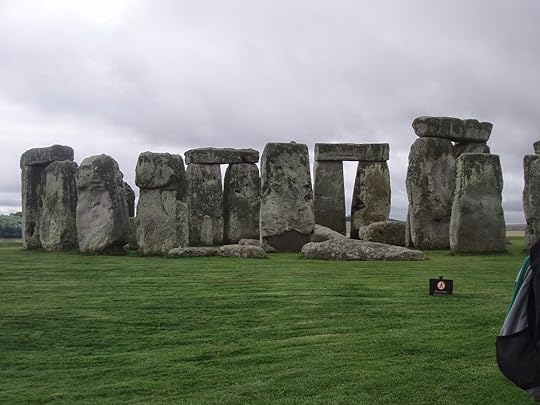
7. Exploring Cornwall, starting at Tintagel
8. Sightseeing in Málaga - especially the locations referenced in The Briton and the Dane Concordia
9. Volcano hopping in Hawaii
10. Visit the Viking Ship Museum in Roskilde, Denmark
Sounds like you've got a great life planned out. Lets hope for a long, fabulous life!
Now...who is Mary Ann Bernal? Give me a few insights, not the normal bio stuff, but the things that really make you...you.
1. I was born on a Navy base. GO NAVY, BEAT ARMY!
I really can't agree with that, but go on.

2. I drive a Honda with 85,000 miles and still going strong.
3. Nancy Walker (actress best known for appearing on the TV show Rhoda) and I almost collided on a sidewalk in Manhattan.
4. I hung out with the First Class flight attendants on a trip from Texas to New York and was introduced to Mickey Mantle who, of course, was flying in First Class.
5. Tom Jones touched my hand during a concert at the Westchester County Center in White Plains, New York.
6. I was the only female in an accelerated program created for US veterans pursuing a Bachelor’s Degree.

7. My favorite color is teal, worn by my favorite football team (Miami Dolphins)
8. While in Bermuda, I had a motorbike accident and severed my right calf muscle. When brought to the clinic, I assisted the doctor, who was also from New York, as he stitched my leg since his nurse had yet to arrive at the office.
Tough...obviously that military upbringing!
 9. Being a proud Trekker, I have attended Star Trek conventions in New York City and have been to the Star Trek Experience at the Las Vegas Hilton, and can be found on the Voyager bridge next to Captain Janeway.
9. Being a proud Trekker, I have attended Star Trek conventions in New York City and have been to the Star Trek Experience at the Las Vegas Hilton, and can be found on the Voyager bridge next to Captain Janeway.
10. I fought off a mugger in the Parking Garage at LaGuardia Airport.
Wow! All of that and an author to top it off. Fantastic! Do you have any links you'd like to share to your work?
Webpage
http://www.maryannbernal.com
Twitter
http://twitter.com/#!/BritonandDane
http://twubs.com/britonanddane
Blog
http://maryannbernal.blogspot.com/
Amazon Links:
The Briton and the Dane: Timeline
Amazon US
http://www.amazon.com/The-Briton-Dane-Mary-Bernal/dp/1494864622/ref=tmm_pap_title_0?ie=UTF8&qid=1393369128&sr=8-1
Amazon UK
http://www.amazon.co.uk/Briton-Dane-Mary-Ann-Bernal-ebook/dp/B00I4WFUOW/ref=sr_1_1?ie=UTF8&qid=1393369096&sr=8-1&keywords=The+briton+and+the+dane+timeline
YOUTUBE - TRAILERS
The Briton and the Dane: Timeline
https://www.youtube.com/watch?v=ijK8NgFL4Ks
The Briton and the Dane: The Complete Trilogy
https://www.youtube.com/watch?v=fH1qSGHOSMA
The Briton and the Dane: Concordia
https://www.youtube.com/watch?v=yDPaiQqmaIs
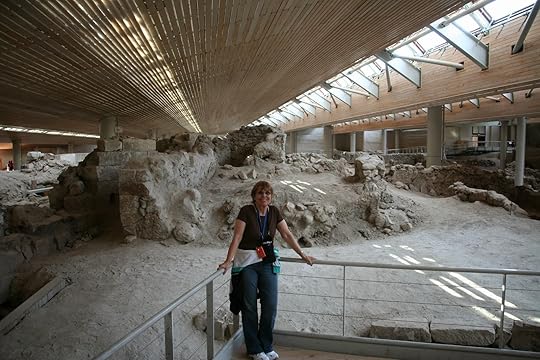
Fantastic! Thank you Mary Ann for stopping by. I wish you great success and "LIVE LONG AND PROSPER!"

.
Writing and RamblingThe official (like there would be an unofficial?!) blog for the author R. Kyle Hannah. Check out my novels: ASSASSIN'S GAMBIT, TIME ASSASSINS and TO AID AND PROTECT!
Wednesday, June 11, 2014Author Interview - Mary Ann BernalJoining me in the studio today, is Ms. Mary Ann Bernal. She is an author, a TV celebrity, and supporter of all things military.
Mary Ann, tell me a little about yourself:

I am the author of The Briton and the Dane novels and an avid history buff whose area of interest focuses on Ninth Century Anglo-Saxon Britain during the Viking Age. While pursuing a degree in business administration, I managed to fit a few creative writing classes and workshops into my busy schedule. Unfortunately, it took decades before my “Erik the Viking” novel was ultimately published.


You said you were an avid supporter of the military?
Yes, I am a very passionate supporter of the United States military. I have been involved with letter writing campaigns and other support programs since Operation Desert Storm.
Thank you for that. As a veteran, its nice to feel appreciated. What is this I hear about a "celebrity" status?
Celebrity? Hardly. I have appeared on The Morning Blend television show hosted by KMTV, the CBS television affiliate in Omaha, and I was interviewed by the Omaha World-Herald for my volunteer work. I have also been a featured author on Triangle Variety Radio, The Phil Naessens Show, and The Writers Showcase, and have been interviewed extensively by American and European bloggers.
I would definitely call that "celebrity!" So, you live in Omaha?
I do currently reside in Omaha, Nebraska, but I am a New York “expat.”
So, leaving New York was on your bucket list? What other things would you like to cross off that list?
1. Getting my pilot’s license
2. Riding in a hot air balloon
3. Parachuting with my nephew, retired US Ranger
4. Attending the Indie 500
5. Spending a week walking the ruins of Pompeii
6. Visiting Stonehenge during the summer solstice

7. Exploring Cornwall, starting at Tintagel
8. Sightseeing in Málaga - especially the locations referenced in The Briton and the Dane Concordia
9. Volcano hopping in Hawaii
10. Visit the Viking Ship Museum in Roskilde, Denmark
Sounds like you've got a great life planned out. Lets hope for a long, fabulous life!
Now...who is Mary Ann Bernal? Give me a few insights, not the normal bio stuff, but the things that really make you...you.
1. I was born on a Navy base. GO NAVY, BEAT ARMY!
I really can't agree with that, but go on.

2. I drive a Honda with 85,000 miles and still going strong.
3. Nancy Walker (actress best known for appearing on the TV show Rhoda) and I almost collided on a sidewalk in Manhattan.
4. I hung out with the First Class flight attendants on a trip from Texas to New York and was introduced to Mickey Mantle who, of course, was flying in First Class.
5. Tom Jones touched my hand during a concert at the Westchester County Center in White Plains, New York.
6. I was the only female in an accelerated program created for US veterans pursuing a Bachelor’s Degree.

7. My favorite color is teal, worn by my favorite football team (Miami Dolphins)
8. While in Bermuda, I had a motorbike accident and severed my right calf muscle. When brought to the clinic, I assisted the doctor, who was also from New York, as he stitched my leg since his nurse had yet to arrive at the office.
Tough...obviously that military upbringing!
 9. Being a proud Trekker, I have attended Star Trek conventions in New York City and have been to the Star Trek Experience at the Las Vegas Hilton, and can be found on the Voyager bridge next to Captain Janeway.
9. Being a proud Trekker, I have attended Star Trek conventions in New York City and have been to the Star Trek Experience at the Las Vegas Hilton, and can be found on the Voyager bridge next to Captain Janeway.10. I fought off a mugger in the Parking Garage at LaGuardia Airport.
Wow! All of that and an author to top it off. Fantastic! Do you have any links you'd like to share to your work?
Webpage
http://www.maryannbernal.com
http://twitter.com/#!/BritonandDane
http://twubs.com/britonanddane
Blog
http://maryannbernal.blogspot.com/
Amazon Links:
The Briton and the Dane: Timeline
Amazon US
http://www.amazon.com/The-Briton-Dane-Mary-Bernal/dp/1494864622/ref=tmm_pap_title_0?ie=UTF8&qid=1393369128&sr=8-1
Amazon UK
http://www.amazon.co.uk/Briton-Dane-Mary-Ann-Bernal-ebook/dp/B00I4WFUOW/ref=sr_1_1?ie=UTF8&qid=1393369096&sr=8-1&keywords=The+briton+and+the+dane+timeline
YOUTUBE - TRAILERS
The Briton and the Dane: Timeline
https://www.youtube.com/watch?v=ijK8NgFL4Ks
The Briton and the Dane: The Complete Trilogy
https://www.youtube.com/watch?v=fH1qSGHOSMA
The Briton and the Dane: Concordia
https://www.youtube.com/watch?v=yDPaiQqmaIs

Fantastic! Thank you Mary Ann for stopping by. I wish you great success and "LIVE LONG AND PROSPER!"

Published on June 11, 2014 19:27
Vikings war song - Fehu by Wardruna
Published on June 11, 2014 08:49
History Trivia - Trojan War: Troy sacked and burned
June 11

1184 BC Trojan War: Troy was sacked and burned, according to calculations by Eratosthenes.

173 Marcomannic Wars: The Roman army in Moravia was encircled by the Quadi, who had broken the peace treaty.
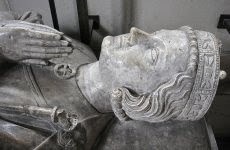
1183 Henry the Young King, second of five sons of King Henry II of England and Eleanor of Aquitaine died.

1346 Charles IV of Luxembourg was elected Holy Roman Emperor. 1
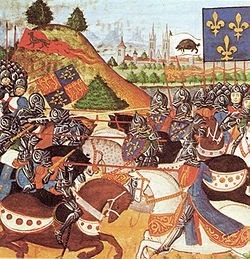
429 Hundred Years' War: start of the Battle of Jargeau, Joan of Arc's first offensive battle.

1456 Anne Neville, wife of Richard III of England was born.

1488 Rebels defeated and deposed James III of Scotland at the Battle of Sauchieburn, making his son, James, king.

1509 Henry VIII of England married Catherine of Aragon, his brother Arthur's widow.


1184 BC Trojan War: Troy was sacked and burned, according to calculations by Eratosthenes.

173 Marcomannic Wars: The Roman army in Moravia was encircled by the Quadi, who had broken the peace treaty.

1183 Henry the Young King, second of five sons of King Henry II of England and Eleanor of Aquitaine died.

1346 Charles IV of Luxembourg was elected Holy Roman Emperor. 1

429 Hundred Years' War: start of the Battle of Jargeau, Joan of Arc's first offensive battle.

1456 Anne Neville, wife of Richard III of England was born.

1488 Rebels defeated and deposed James III of Scotland at the Battle of Sauchieburn, making his son, James, king.

1509 Henry VIII of England married Catherine of Aragon, his brother Arthur's widow.

Published on June 11, 2014 03:57
June 10, 2014
Tapeworm-Like Fossil Suggests Origins of Left and Right
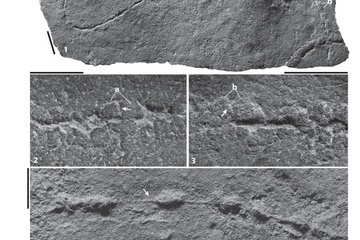
 Traces of the tapeworm-like creature Plexus ricei as seen in the fossil record. Individuals were likely 2 to 31 inches (5 to 80 cm) long.
Traces of the tapeworm-like creature Plexus ricei as seen in the fossil record. Individuals were likely 2 to 31 inches (5 to 80 cm) long.Credit: Droser Lab, UC Riverside By Elizabeth Howell
A puzzling fossil find from the Ediacaran period, an era that occurred more than 500 million years ago, has scientists curious about how "bilateral" creatures such as humans evolved.
The Plexus ricei organism resembled a tapeworm or flatworm. Mysteriously, it appears to have had "bilateral", or left-right, symmetry before anything else living 540 million to 575 million years ago.
"Plexus was unlike any other fossil that we know from the Precambrian," said study researcher Mary Droser, a paleobiologist at the University of California at Riverside, in a statement. The Precambrian was the period before abundant animal life appeared on our planet, and represents latter part is called the Ediacaran period.
"It was bilaterally symmetrical at a time when bilaterians — all animals other than corals and sponges — were just appearing on this planet." [In Photos: Spooky Deep-Sea Creatures]
Tube worm
The tubular creature was about 5 to 80 centimeters (2 to 31 inches) in length and 5 to 20 millimeters (0.2 inches to 0.78 inches) wide, and it lived on the seafloor. That wasn't unusual, as all life on Earth lived in the oceans during this time. The earliest evidence of a bilaterally symmetrical organism comes from about 585 million years ago. That slug-like animal, less than a half-inch long, left itsy-bitsy tracks found fossilized in Uruguay.
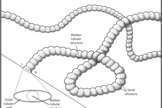 [image error]
[image error]
 Here, a reconstruction of the tapeworm-like creature Plexus ricei, which lived more than 500 million years ago.
Here, a reconstruction of the tapeworm-like creature Plexus ricei, which lived more than 500 million years ago. Credit: Droser Lab, UC RiversideView full size image"Ediacaran fossils are extremely perplexing: They don’t look like any animal that is alive today, and their interrelationships are very poorly understood," Lucas Joel, a former graduate student at UC Riverside who led the research, said in a statement.
The Ediacaran period also lacked bioturbation, Joel said, or churned-up seafloors from marine organisms snuffling for food.
It was only in the Cambrian period — the explosion of life that started around 540 million years ago — that organisms began churning up the seafloor. By contrast, large algae mats carpeted the Ediacaran oceans, a rare occurrence on Earth today.
Tricky identity
Because the seafloor remained undisturbed, organisms that died and drifted to the ocean floor were preserved when sediments accumulated over their bodies, creating a mold.
"What this means is that the fossils we see in the field are not the exact fossils of the original organism, but instead molds and casts of its body," Joel said. That makes it sometimes difficult to tell if a fossil represents an organism like Plexus or simply an empty burrow created by a long-ago creature worming its way through the sand.
Joel and his colleagues discovered that Plexus ricei was not, in fact, a trace fossil (fossil of an organism's path), but rather was an unknown organism. The species gets its name from the Latin word "plexus," which means braided, and from Dennis Rice, a field assistant at the South Australian Museum who excavated many specimens of Plexus.
Droser said researchers need to confirm that Plexus was truly bilateral, but the scientists suspect that this tapeworm-like creature is a distant ancestor of other bilateral organisms — including humans.
http://www.livescience.com/46206-tapeworm-fossil-reveals-bilateral-symmetry.html

Published on June 10, 2014 08:35
Archaeologists discover 4,000-year-old tomb from 11th dynasty in Luxor
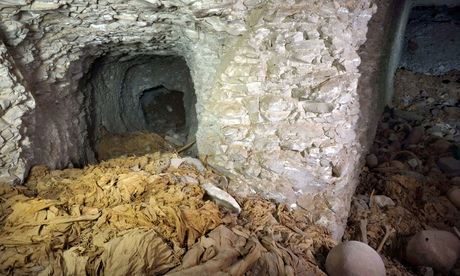 Spanish team find large pharaonic tomb that was probably built for a member of the royal family or a high-ranking statesman The entrance of the tomb found by Spanish archaeologists, who said the discovery would reveal new details about the 11th dynasty. Photograph: AFP/Getty The entrance of the tomb found by Spanish archaeologists, who said the discovery would reveal new details about the 11th dynasty. Photograph: AFP/GettySpanish archaeologists have discovered a 4,000-year-old pharaonic tomb belonging to a leader from the 11th dynasty of Egypt in Luxor, the antiquities ministry said on Monday.
Spanish team find large pharaonic tomb that was probably built for a member of the royal family or a high-ranking statesman The entrance of the tomb found by Spanish archaeologists, who said the discovery would reveal new details about the 11th dynasty. Photograph: AFP/Getty The entrance of the tomb found by Spanish archaeologists, who said the discovery would reveal new details about the 11th dynasty. Photograph: AFP/GettySpanish archaeologists have discovered a 4,000-year-old pharaonic tomb belonging to a leader from the 11th dynasty of Egypt in Luxor, the antiquities ministry said on Monday.The wide surface of the tomb showed it was that of "someone from the royal family or a high-ranking statesman," the antiquities minister, Mohamed Ibrahim, said.
The Spanish team was led by José Galán, who said the tomb would provide new insights into the dynasty that ruled in Luxor, the modern site of the city of Thebes, which was then the capital of ancient Egypt.
"This discovery confirms the presence of many tombs from the 11th dynasty in the Deraa Abu Naga region," said Galán.
One tomb dating back to the same period was discovered in the area five years ago. It contained a red sarcophagus, a well-preserved mummy, as well as arrows and arches that are now on display in Luxor's museum.
"The tomb may have been used as a mass grave, given the high number of human remains [discovered in it]," Ali al-Asfar, an antiquities ministry official, said on Monday, referring to the newly discovered site.
But it was also used during the 17th dynasty as pottery tools and utensils from this period were discovered in the tomb, Asfar added.
Luxor, a city of some 500,000 people on the banks of the Nile in southern Egypt, is an open-air museum of intricate temples and pharaonic tombs.
http://www.theguardian.com/science/2014/jun/09/archaeologists-discover-4000-year-old-pharaonic-tomb-luxor-egypt

Published on June 10, 2014 08:24
History Trivia - Alexander the Great dies
June 10,

323 BC (or June 11) Alexander the Great, Macedonian king, died from either fever or excessive wine at the age of 32.

1190 Holy Roman Emperor Frederick Barbarossa drowned while crossing a river on a crusade to the Holy Land.
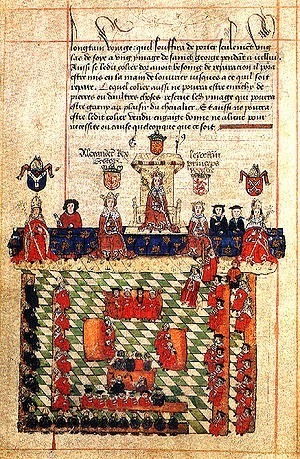
1258 Provisions of Oxford issued, which is considered to be England's first written constitution.

1540 Thomas Cromwell arrested in Westminster after falling out of favor with Henry VIII for having arranged the King's marriage to Anne of Cleves, which was quickly annulled.


323 BC (or June 11) Alexander the Great, Macedonian king, died from either fever or excessive wine at the age of 32.

1190 Holy Roman Emperor Frederick Barbarossa drowned while crossing a river on a crusade to the Holy Land.

1258 Provisions of Oxford issued, which is considered to be England's first written constitution.

1540 Thomas Cromwell arrested in Westminster after falling out of favor with Henry VIII for having arranged the King's marriage to Anne of Cleves, which was quickly annulled.

Published on June 10, 2014 04:16
June 9, 2014
Holocaust Denial and Conspiracy Theories Won't Solve World Problems (Op-Ed)
Jeff Nesbit
![Expertvoices_02_ls_v2[2]](https://i.gr-assets.com/images/S/compressed.photo.goodreads.com/hostedimages/1402390606i/9930330._SX540_.jpg) [image error] [image error]
[image error] [image error] 
 Hungarian Jews arrive at the German Nazi death camp Auschwitz in Poland in Summer 1944.
Hungarian Jews arrive at the German Nazi death camp Auschwitz in Poland in Summer 1944.
Credit: Public domain. View full size image Jeff Nesbit was the director of public affairs for two prominent federal science agencies. This article was adapted from one that first appeared in U.S. News & World Report. Nesbit contributed the article to Live Science's Expert Voices: Op-Ed & Insights.
The Anti-Defamation League (ADL) released an interesting, thought-provoking report recently on anti-Semitic views around the world. It was based on answers to 11 questions posed to tens of thousands of people in nearly 100 countries.
The main finding — that a quarter of the populations in these countries harbor anti-Semitic views — spurred considerable controversy. Commentators across the globe either praised ADL for its focus and findings, or condemned the group for creating "loaded" questions designed to lead respondents toward anti-Semitic views.
"Instead of designing a neutral questionnaire that would compare anti-Jewish attitudes to negative attitudes about other religions or ethnicities, it asked a series of 11 questions that stacked the deck in favor of anti-Semitic answers. It then defined you as an anti-Semite if you answered yes to six of the 11 questions," Noah Feldman wrote in Bloomberg View.
"The results might tell you something about relative degrees of anti-Semitism in different places — surprise: Saudis have a more negative attitude toward Jews than Danes do," Feldman wrote. "But other than the rhetorical effect of announcing that a quarter of the world’s people are anti-Jewish, the poll offers precious little in the way of actual knowledge."
However, overlooked by nearly every story about the ADL study was an equally disturbing finding that speaks volumes about why so many complicated or controversial political issues like marriage equality, climate change, gun control, healthcare reform or civil rights are hashed out in hysterical, mindless or irrational ways in the public square.
Half of the people in the world have never heard of the Holocaust, ADL found.
And in the other half — the ones who have at least heard of the Holocaust and the truth that Adolf Hitler ordered the deaths of 6 million Jews — a third of this group simply did not believe the Holocaust happened. To this group, the Holocaust is a lie, a myth, a hoax or a conspiracy by those with a political or ideological agenda.
This level of ignorance of the truth of history is mind-boggling. But it’s also the basis of deep conspiracy theories in lots of other areas where facts, evidence and science should settle a dispute or question and lead to rational or civil discourse — but doesn't.
If half the world has never heard of an event central to the course of political affairs since World War II — and a significant portion of the remaining population simply denies the factual reality of that event — then how can society reasonably expect rational, evidence-based dialogue in public arenas around an issue like the Israeli-Palestinian conflict?
We can't.
Sadly, that’s what this other, overlooked finding from the ADL global survey tells us. When so much of the public either doesn't know about big, important facts — or willfully dismisses them as hoaxes, lies or conspiracies — then we have essentially lost any ability to separate fact from fiction and resolve disputes based on evidence.
There are plenty of examples of this in other areas. A quarter of Americans don't believe tens of thousands of leading scientists who have now essentially ended the question of whether climate change is real, starting to happen now, and mostly caused by carbon-pollution sources.
Science has also largely settled central questions about human sexual orientation, substantive genetic differences between races in the human species, mental illness as a disease, or the efficacy of vaccines. But that hasn't stopped irrational political disputes in these areas — even as the level of scientific certainty and knowledge has deepened.
It does beg the question, though: How is it actually possible that half of the world has never heard of the Holocaust, and that a very large portion of the remainder denies that it ever even happened? What, exactly, do they believe happened at Auschwitz, Dachau and Buchenwald?
We're fortunate in the United States that teachers generally hew closely to fact- and evidence-based curricula — though this is starting to erode as anti-science, ideological agendas creep into studies in areas such as evolution and climate change. Our curricula at least give Americans a fighting chance at baseline knowledge of essential facts important to a functioning democratic society.
I was lucky. I had an inspiring World Affairs teacher in my public high school in Fort Wayne, Ind., who chose to teach us the histories of Nazi Germany by re-enacting the Nuremberg trials. Largely because no one else wanted the extra work, I volunteered to serve as the lead prosecutor of the Nazi criminals during our mock trials. [image error]
[image error]
 If you're a topical expert — researcher, business leader, author or innovator — and would like to contribute an op-ed piece, email us here.
If you're a topical expert — researcher, business leader, author or innovator — and would like to contribute an op-ed piece, email us here.
View full size image
During the course of preparing for that mock trial in the classroom, I was forced to read volumes of history on what happened at those concentration and extermination camps in Nazi Germany throughout World War II.
It left a permanent impression, and I am thankful to that teacher for the gift he gave me. Reading through factual accounts of what happened during the Holocaust allowed me to build a moral and legal case against the Nazi war criminals in a mock trial setting — but also created a genuine hunger for knowing the core truth: science and facts behind public issues that are not rooted in religious, political or ideological beliefs. It's why I became a journalist.
There is a trite, overworked saying that the truth will set you free. That is certainly useful in most cases — unless, of course, you don’t know it, ignore it or simply don't believe it.
That's why the ADL findings, in the end, are so unsettling. If most of the world doesn't know or recognize central, factual realities like the Holocaust, how can we reasonably expect the public to support political, moral or legal actions that depend on at least a basic understanding of the scientific or factual basis of things?
It's a difficult question — with no satisfying answers.
http://www.livescience.com/46176-holocaust-denial-and-empirical-arguments.html
![Expertvoices_02_ls_v2[2]](https://i.gr-assets.com/images/S/compressed.photo.goodreads.com/hostedimages/1402390606i/9930330._SX540_.jpg) [image error] [image error]
[image error] [image error] 
 Hungarian Jews arrive at the German Nazi death camp Auschwitz in Poland in Summer 1944.
Hungarian Jews arrive at the German Nazi death camp Auschwitz in Poland in Summer 1944.Credit: Public domain. View full size image Jeff Nesbit was the director of public affairs for two prominent federal science agencies. This article was adapted from one that first appeared in U.S. News & World Report. Nesbit contributed the article to Live Science's Expert Voices: Op-Ed & Insights.
The Anti-Defamation League (ADL) released an interesting, thought-provoking report recently on anti-Semitic views around the world. It was based on answers to 11 questions posed to tens of thousands of people in nearly 100 countries.
The main finding — that a quarter of the populations in these countries harbor anti-Semitic views — spurred considerable controversy. Commentators across the globe either praised ADL for its focus and findings, or condemned the group for creating "loaded" questions designed to lead respondents toward anti-Semitic views.
"Instead of designing a neutral questionnaire that would compare anti-Jewish attitudes to negative attitudes about other religions or ethnicities, it asked a series of 11 questions that stacked the deck in favor of anti-Semitic answers. It then defined you as an anti-Semite if you answered yes to six of the 11 questions," Noah Feldman wrote in Bloomberg View.
"The results might tell you something about relative degrees of anti-Semitism in different places — surprise: Saudis have a more negative attitude toward Jews than Danes do," Feldman wrote. "But other than the rhetorical effect of announcing that a quarter of the world’s people are anti-Jewish, the poll offers precious little in the way of actual knowledge."
However, overlooked by nearly every story about the ADL study was an equally disturbing finding that speaks volumes about why so many complicated or controversial political issues like marriage equality, climate change, gun control, healthcare reform or civil rights are hashed out in hysterical, mindless or irrational ways in the public square.
Half of the people in the world have never heard of the Holocaust, ADL found.
And in the other half — the ones who have at least heard of the Holocaust and the truth that Adolf Hitler ordered the deaths of 6 million Jews — a third of this group simply did not believe the Holocaust happened. To this group, the Holocaust is a lie, a myth, a hoax or a conspiracy by those with a political or ideological agenda.
This level of ignorance of the truth of history is mind-boggling. But it’s also the basis of deep conspiracy theories in lots of other areas where facts, evidence and science should settle a dispute or question and lead to rational or civil discourse — but doesn't.
If half the world has never heard of an event central to the course of political affairs since World War II — and a significant portion of the remaining population simply denies the factual reality of that event — then how can society reasonably expect rational, evidence-based dialogue in public arenas around an issue like the Israeli-Palestinian conflict?
We can't.
Sadly, that’s what this other, overlooked finding from the ADL global survey tells us. When so much of the public either doesn't know about big, important facts — or willfully dismisses them as hoaxes, lies or conspiracies — then we have essentially lost any ability to separate fact from fiction and resolve disputes based on evidence.
There are plenty of examples of this in other areas. A quarter of Americans don't believe tens of thousands of leading scientists who have now essentially ended the question of whether climate change is real, starting to happen now, and mostly caused by carbon-pollution sources.
Science has also largely settled central questions about human sexual orientation, substantive genetic differences between races in the human species, mental illness as a disease, or the efficacy of vaccines. But that hasn't stopped irrational political disputes in these areas — even as the level of scientific certainty and knowledge has deepened.
It does beg the question, though: How is it actually possible that half of the world has never heard of the Holocaust, and that a very large portion of the remainder denies that it ever even happened? What, exactly, do they believe happened at Auschwitz, Dachau and Buchenwald?
We're fortunate in the United States that teachers generally hew closely to fact- and evidence-based curricula — though this is starting to erode as anti-science, ideological agendas creep into studies in areas such as evolution and climate change. Our curricula at least give Americans a fighting chance at baseline knowledge of essential facts important to a functioning democratic society.
I was lucky. I had an inspiring World Affairs teacher in my public high school in Fort Wayne, Ind., who chose to teach us the histories of Nazi Germany by re-enacting the Nuremberg trials. Largely because no one else wanted the extra work, I volunteered to serve as the lead prosecutor of the Nazi criminals during our mock trials.
 [image error]
[image error]
 If you're a topical expert — researcher, business leader, author or innovator — and would like to contribute an op-ed piece, email us here.
If you're a topical expert — researcher, business leader, author or innovator — and would like to contribute an op-ed piece, email us here.View full size image
During the course of preparing for that mock trial in the classroom, I was forced to read volumes of history on what happened at those concentration and extermination camps in Nazi Germany throughout World War II.
It left a permanent impression, and I am thankful to that teacher for the gift he gave me. Reading through factual accounts of what happened during the Holocaust allowed me to build a moral and legal case against the Nazi war criminals in a mock trial setting — but also created a genuine hunger for knowing the core truth: science and facts behind public issues that are not rooted in religious, political or ideological beliefs. It's why I became a journalist.
There is a trite, overworked saying that the truth will set you free. That is certainly useful in most cases — unless, of course, you don’t know it, ignore it or simply don't believe it.
That's why the ADL findings, in the end, are so unsettling. If most of the world doesn't know or recognize central, factual realities like the Holocaust, how can we reasonably expect the public to support political, moral or legal actions that depend on at least a basic understanding of the scientific or factual basis of things?
It's a difficult question — with no satisfying answers.
http://www.livescience.com/46176-holocaust-denial-and-empirical-arguments.html

Published on June 09, 2014 14:33




